Drone Utility Inspection ROI:
How Much Do Power Line Drones Actually Save?
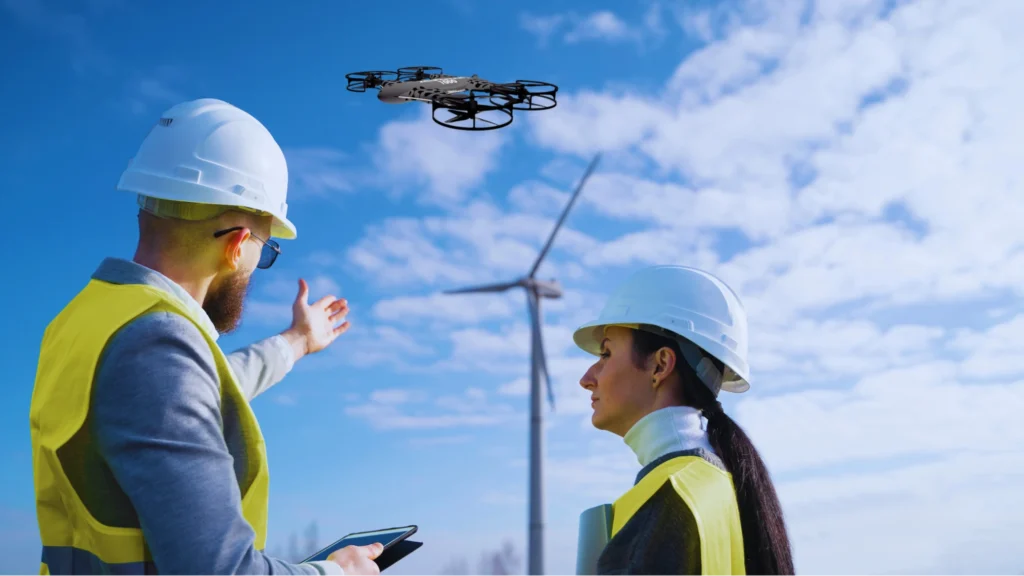
Maintaining the power lines has always been a task that can be costly and risky. The process of hiring helicopters to send workers to climb dangerous towers, along with the traditional method of inspecting them, continues to strain budgets while also exposing workers to various hazards.
The problem is evident: manual inspection methods are not cost-effective and lack efficiency, failing to provide the data needed for effective maintenance. The risks are high, and there is limited visibility into the infrastructure, which makes it harder to prevent outages.
This is where drone power line inspection, also known as aerial power line inspection, comes along, as an effective and accurate solution for inspection struggles.
Using UAV technology, utilities can reduce risks and cut costs while gathering accurate and precise data in less time.
In this blog, we will explore how drone inspections deliver measurable ROI for your business while comparing the cost to the long-term benefits. Predictive maintenance can be achieved by adapting drones as a strategic investment, not just an operational tool, for the future of your business and utility management.
What is Drone Utility Inspection?
Drone utility inspection refers to unmanned aerial inspections using drones to analyze and monitor electrical infrastructure, enabling precise electrical infrastructure monitoring, detailed data collection, and efficient asset management for utility companies. In this way, there will be no reliance on workers and crews to climb high structures or use helicopters, which usually cost more than the use of drones.
UAV power line inspections provide a safer, faster, and accurate method while making it more cost-effective. With the ability of drones to capture high-resolution images and advanced sensor readings, the UAV inspections are transforming the way of managing assets and utilities.
UAV power line inspections are mainly used by businesses to fly along transmission lines and related infrastructure. This method involves sending drones equipped with specialized sensors to survey the area and capture data that can be analyzed to identify issues, plan maintenance, and prevent operational failures.
What are the Types of Drone Inspections?
There are mainly 4 types of drone inspections. Let’s discover the different types that help businesses enhance safety, cut costs, and improve efficiency.
-
- Visual Inspections: These are drones that are equipped with HD cameras to capture videos and photos of towers, poles, and insulators. The images provide information to detect cracks and corrosion.
-
- Thermal Inspection: Infrared cameras can identify faulty connections, energy loss in an area, and overheating components, which can’t be seen by the naked eye alone.
-
- LiDAR Inspections: LiDAR sensors collect and generate 3D maps of the surroundings of power lines. This data collected is crucial for vegetation management, clearance checks, and creating digital twins for utility networks.
-
- AI-Assisted Inspections: Drones can automatically highlight all the risks and faults with AI-powered defect detection, which generates accurate reports and reduces the reliance on manual review.
Benefits of Drone Utility Inspections
There is some constant pressure, especially for utility companies, to deliver reliable service while keeping costs low. Having a reliable aerial utility inspection with drones offers a powerful solution by making smarter workflows and adding advanced technology.
The inspection process is not only faster and safer but also offers an accurate solution rather than the traditional methods. Let’s try to unlock safer, faster, and more cost-efficient inspections for critical utility infrastructure with
Here are the key benefits of drone utility inspections, enhanced through AI-powered defect detection and predictive maintenance capabilities:
-
- Cost Savings: Drones lower operational costs by reducing the need for traditional methods, such as helicopters, large crew inspectors, and repairs. It also extends the life of all the critical assets.
-
- Improved Safety: With drones taking on tasks like climbing hazardous areas and flying near live wires or transmission towers, workers are less prone to accidents during inspection routines.
-
- Speed and Efficiency: Drone UAV inspection can cover vast areas of electrical lines in a small amount of time compared to the ground teams, allowing consistent monitoring.
-
- Data Accuracy: Utilizing thermal sensors, LiDAR, high-resolution cameras, and drones, these technologies consistently deliver detailed inspections that surpass the level of detail achievable through manual inspections. This data supports the predictive maintenance strategies that save businesses from failures before they even occur.
-
- Scalability: Drone inspections can also be scaled to meet the demands of the work without compromising the quality. Whether it’s monitoring a small regional grid or a nationwide network, it ensures safety and accurate data.
ROI Factors and Long-Term Benefits
Many utility companies are adopting drones for monitoring their infrastructure, and it’s not just about embracing innovation; it’s about making smarter financial decisions. The discussion on whether there is a return on investment (ROI) in using drones for inspections can be summarized as follows: traditional methods of inspections can be costly.
According to the ScienceDirect article, Drone inspections can reduce total costs by 30–50%, and with automated utility inspections powered by predictive analytics, companies achieve measurable ROI and smarter decisions.
Traditional inspection methods, such as sending ground crews, climbing towers, and using helicopters to cover large spans, can be costly, risky, and time-consuming for drone electrical inspections of power lines.
Whereas the drone power line inspection cost is lower, it also ensures quality results. UAVs reduce the number of personnel needed; they also eliminate the need for helicopters, allowing for faster completion of the inspection.
Traditional Inspection VS Done Inspection
For better understanding, let’s see how drones transform utility inspections when compared directly with traditional approaches:
| Factors | Traditional Inspection | Drone Inspection |
| Cost | High Costs – Trucks, crews, helicopters | Low Costs – One drone team can cover it efficiently |
| Safety | Significant – Live wire exposures, climbing of towers, and hazardous areas | Minimal – Pilots of drones stay safely on the site |
| Speed | Slower – This can be labor-intensive, and manual | Faster – UAVs scan miles of line power in a single flight. |
| Quality | Limited – Prone to human error since visual data is the only data | High – Thermal scans, LiDAR 3D mapping, and HD images |
| Maintenance | Reactive – There can be existing issues again after inspections | Predictive – Can detect the early risks to reduce repair costs. |
Well, these are the advantages of drone inspections over the traditional methods. It is also important to note that ROI can vary depending on the needs of the utility company.
What Determines the Cost and Value of Drone Inspections?
-
- Grid Size: Having large grids results in higher savings due to the scale.
-
- Inspection Frequency: If you inspect often, it can maximize the efficiency of drones.
-
- Drone Model & Sensors: Higher-end UAVs, thermal sensors, and LiDAR capabilities can cost more but also give accurate and efficient insights.
-
- Software Analytics: The integration of data into AI-powered platforms ensures that insights are actionable and there is smarter maintenance planning.
When these factors are used and optimized, drones can be self-paying in terms of their usage, especially for utilities that manage thousands of miles of power lines.
In short, there are long-term benefits of drone inspections that truly drive the ROI. With drones, utilities can adopt predictive maintenance strategies by monitoring the assets remotely.
Smarter Inspections with AI & Sensors
The thermal cameras, LiDAR sensors, and AI-powered analytics help detect issues such as structural weaknesses and overheating. This shift toward proactive management not only reduces downtime and repair costs but also extends the lifespan of infrastructure.
Automated utility inspections further strengthen the foundation for long-term asset management, enabling utility companies to use this data over time to optimize repair schedules and allocate resources more effectively.
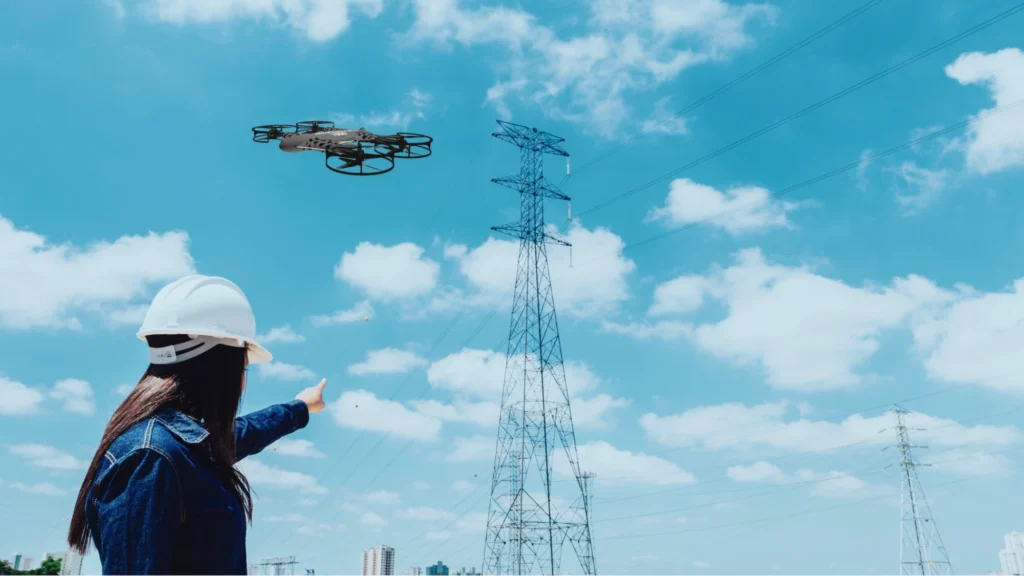
Core Technologies for Drone Utility Operations
Drone utility inspections are effective because of the specialized technologies that are made for analyzing, monitoring, and maintaining infrastructures.
Here are some of the technological advancements that help drones for utility operations.
-
- High-Resolution Cameras: The high-resolution cameras are the ones that capture detailed images of poles, conductors, insulators, and towers, which allows operators to identify the physical issues, such as cracks or loose fittings. The visual inspections are ideal for routine assessment and maintenance.
-
- Thermal Imaging Sensors: This tool detects the heat variations that are invisible to the naked eye. It also identifies the overheating, energy loss, and malfunctions, such as overloaded lines of damaged transformers.
-
- 3D Mapping and Modeling: This involves laser pulses in creating an accurate representation of powerlines and substations in three dimensions. The 3D visuals are needed for clearance checks and management purposes. This ensures that it complies with safety and engineering standards.
-
- AI-powered Analytics: These enhance the efficiency and accuracy of the inspection result. AI processes the data collected by the drone, detecting defects automatically. It reduces error and analysis time, which is efficient for companies.
-
- GPS/GNSS-Enabled Navigation Systems: The technology that combines GPS and GNSS navigation systems enables drones to follow precise flight paths. Also, it records the location of inspection points and ensures the consistency of data collected.
-
- Cloud-based Data Platforms: With these tools, the data is uploaded, processed, and shared. The cloud-based platforms allow the team to access the LiDAR, visual, and thermal results.
How Drone Inspections Improve Utility Operations?
The value of drones is beyond saving costs; it improves the way utility companies manage and maintain their infrastructure. The combination of advanced sensors with data analytics empowers companies to perform smarter inspections, making operations faster, safer, and more reliable. Here’s how they do it:
Better Data Collection & Mapping
One significant advantage of deploying drones for inspections is that they can power predictive maintenance strategies for infrastructures. Utilization of AI-powered defect detection on drone-gathered data can help utilities spot early warning signs of failure, such as alarms of overheating lines, structure fatigue, or vegetation encroachment, long before they escalate into costly outages.
Applying this approach will lead to less downtime and better grid reliability.
Predictive Maintenance & Analytics
Drone inspections may even influence this increase in predictive maintenance strategies, which range from detecting defects using AI-powered analytics. They can find issues like the proverbial overheating. lines, vibration/friction disabilities, or vegetation influence, which could lead to a forced outage if not detected early.
Towards preventive action, rather than just reactive, as earlier. This helps maintain high grid uptime and high-quality service.
Faster Decision-Making
When it comes to keeping power online, speed is everything. Drones are the key ingredient here by providing real-time actionable insights that allow utility managers to be super responsive to potential issues.
What took a lot of man-hours just to read may now be analyzed and put into action in hours.
Automation for Repeatable Inspections
Monitoring large-scale infrastructure is all about doing things the same way every time. When you program drones to fly in a standardized way, they can perform repeatable automated inspections. This assures data can be compared across time periods to generate a reliable performance baseline for compliance monitoring.
How Much Do Drone Inspections Cost for Utility Companies?
Implementing drones for utility inspections is an investment that requires careful consideration. Although the cost savings are obvious over the long term, companies must first calculate the expenses associated with hiring someone else or setting up a drone for electric utility inspections. However, this does come with its share of costs.
Equipment Purchase
Advanced drone electrical inspections often use high-quality cameras, thermal sensors, or LiDAR payloads for detailed data collection. Depending upon the model, these can set one back anywhere from a few thousand to tens of thousands of dollars. Companies that prefer to outsource may instead partner with a service provider already flying drones for utility inspections.
Training and Certifications
In fact, pilots need to adhere to regional aviation regulations, and ongoing training ensures that flights are safe and productive. By investing in skilled operators, utilities can maximize the value captured in each UAV power line inspection.
Reliable Drone Software Solution
Drones generate large quantities of imagery and sensor data, which requires specialized platforms to process. Ranging from AI-driven defect detection to 3D mapping and predictive analytics, software subscriptions are an ongoing cost, but also where much of the ROI is derived from.
Insurance for Drone Operations
Also, maintenance and insurance should not be forgotten but rather be kept in routine, since UAVs require routine calibration to stay reliable. Also, liability coverage ensures companies are also protected during the inspection, even if issues arise.
Utility companies should find drone inspection companies that can support their needs and are still less expensive but deliver accuracy and reliability. And more importantly, they provide better data, which lays a foundation for long-term efficiency as well as improvements in grid reliability.
Common Challenges and Solutions for UAV Inspections
However, incorporating UAVs into power company operations introduces several challenges. Some of the common challenges include regulatory barriers, physical location problems, and, of course, privacy issues—all of which need to be tackled for scaling inspections.
Regulatory Compliance
Every autonomous flight system must adhere to FAA regulations in the US, EASA rules in Europe, or depending on the locality or national flight rules of a country. Utilities have to follow all these rules to make sure they are legally allowed to fly these systems, which may include licenses, certification, or flight validation applications.
Environmental Issues
Companies must pause operations when working in severe weather, high winds, or when the data being captured becomes erratic due to a nearby transmission line. This situation requires a great deal of meticulous hard work to balance safety and reliable data collection.
Data Security
Protecting the critical infrastructure data collected through UAVs becomes a huge challenge to secure from cyber threats. The information needs to be encrypted, securely stored, and controlled so that sensitive images aren’t leaked.
There are established ways in which utilities can overcome these challenges. Ensuring fly path standardization will guarantee that the same data is being gathered for all inspections.
Drones can be integrated to predict maintenance programs, which help in taking early insights for proactive repairs rather than a reactive decision. And to reduce operational hazards, both for pilots and the maintenance team, they rely on stringent safety protocols.
Bottom line: Drone inspection is not only about drones; it is more about UAVs, regulation, infrastructure risk, and the operational set of couriers.
Advanced Applications & Future Trends
Drones are capable of doing more than ever before, and the future of utility inspections is even more promising. New advancements in technology, however, will take UAVs to a level of full-scale intelligent systems that can also seamlessly integrate into grid management, creating comprehensive solutions.
The big evolution is AI-powered defect detection, which also allows drones to analyze imagery and censored data. When there is an issue in the infrastructure, the utility doesn’t have to wait for a live review; it will simply have an alert on hot spots, structural issues, or vegetation issues.
Also making a huge difference is the integration of a digital twin for utilities. This matches up drone-captured LiDAR data with thermal data to create a 3D model of the actual asset. This provides an easy real-time view of the asset’s health for engineers planning maintenance or forecasting long-term needs.
Look forward to autonomous drone operations, which will mean you won’t have to deploy a pilot each time. Drones will launch, inspect, and return to charge and store with minimal human interaction.
Lastly, the improvement in thermal and LiDAR analysis to detect faults more precisely. The use of better imaging solutions and mapping utilities can help keep track of changes over time that could lead to failures before they happen.
Frequently Asked Questions (FAQs)
What Kind of Sensors Do Drones for Power Line Inspection Use?
For the most part, drones come equipped with HD cameras, thermal sensors with infrared systems to capture radiation, and LiDAR sensors for utilities. It provides you with a lot of details, along with hotspot generation, generating accurate 3D maps for all sorts of evaluations.
How Do Drone Inspections Pay Off for Utility Costs?
The significant reduction in emergency repair costs measures the ROI of power line inspection with a drone. Sometimes, achieving a satisfying ROI from drone inspections for power line utilities is as simple as lowering inspection costs and reducing shutdowns. In the long run, the focus of the course then goes to gaining efficiencies.
What Certificates or Rules Does a Drone Have to Follow Under Drone Inspections for Utilities?
Based on location, drone utility inspection guidelines, such as those established by the FAA in the US and the EASA in Europe, are prevalent. Utilities typically hold UAV inspection certifications to ensure strict adherence to preliminary flight rules, depending on the operation’s location.
How Does Done as a Service (DaaS) Create Scheduling for a Large Grid of Drone Inspections of Utilities?
In such cases, this is also made possible due to drone fleet management systems that ensure automated flight planning across very large distances. This smart grid then ensures timely, yet reduced, spending on increased energy transmission monitoring.
Can Drones Fully Replace Traditional Power Line Inspections?
Although drones further speed up automated utility inspections & increase their safety compared to relying solely on physical surveys of these tall structures, they also ease the manual grunt work. Eliminating them all to gather benefits and reduce risk.
Why Choose Drone as a Service (DaaS) for Utility Drone Inspection?
While many utility companies invest in building their own drone programs, partnering with a Drone as a Service (DaaS) provider offers greater flexibility, scalability, and cost efficiency. Instead of managing hardware, training, and compliance internally, DaaS allows companies to leverage a fully managed inspection service — from flight planning to AI-based data analytics.
Here’s why DaaS stands out as the smarter choice for utilities:
Cost-Effective and Scalable Operations
With DaaS, there’s no need to purchase expensive drone fleets or hire specialized operators. Service providers handle all the logistics, letting utilities scale inspections based on project size and budget while maintaining predictable operational costs.
Access to Advanced Technology
DaaS partners use high-end UAVs equipped with LiDAR, thermal, and AI-powered sensors, ensuring detailed and reliable inspection data without the need for in-house upgrades or maintenance.
Compliance and Safety Assurance
Operating drones in regulated airspace requires adherence to strict aviation rules. DaaS providers ensure full compliance with FAA regulations by employing FAA Part 107–certified pilots and operating FAA-registered drones, helping utilities reduce administrative and legal burdens.
Faster Data Delivery and Analysis
DaaS integrates cloud-based platforms and AI analytics for rapid data processing. This enables near real-time insights for maintenance teams, improving response times and decision-making.
Focus on Core Operations
By outsourcing inspections, utilities can redirect their internal teams to focus on maintenance, planning, and infrastructure improvements — while the DaaS team handles inspection efficiency and data accuracy.
In short, Drone as a Service eliminates the complexities of drone ownership while providing utilities with actionable insights, faster turnaround, and measurable ROI — making it the ideal solution for large-scale, data-driven infrastructure management.
Smarter Inspections, Stronger Returns with Drone Utility Inspections
Drone inspection of utilities has evolved from a futuristic concept to an accepted solution that saves money, enhances safety, and boosts productivity. This switch makes utility inspections by drones a much more data-rich process than previous manual operations, and they can increase worker safety by cutting risks, enabling a significantly better ROI with predictive maintenance.
There is no question that drones are not just improving inspections but also changing the way power grids are managed for long-term reliability. Minimize costs, less pain—allow drones to inspect, maintain, and sustain! Explore the new frontier of inspections with Drone as a Service (DaaS).
Read Our Other Blogs
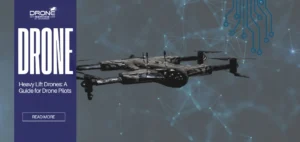
05 December 2025
Heavy Lift Drones: A Guide for Drone Pilots
Heavy Lift Drones: A Guide for Drone Pilots Heavy lift drones are uncrewed aerial vehicles (UAVs) built to carry heavy...

04 December 2025
10 Illegal Drone No-Fly Zones in the United States You Must Know
10 Illegal Drone No-Fly Zones in the United States As drone use grows across photography, mapping, inspections, and security, the...
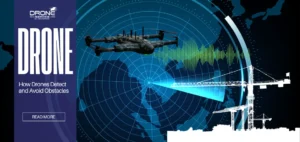
03 December 2025
How Drones Detect and Avoid Obstacles
How Drones Detect and Avoid Obstacles Drones are rapidly becoming essential tools for surveying, inspection, and delivery, thanks to major...

02 December 2025
Law Enforcement Drone: The complete guide
Law Enforcement Drone: The complete guide Drones are rapidly transforming modern policing. Once experimental, law enforcement drones are now standard...
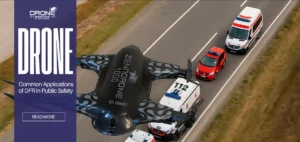
01 December 2025
Drone as First Responder (DFR) Program and Its Benefits
Drone as First Responder (DFR) Program and Its Benefits Emergency response is changing quickly as new technology reshapes how first...
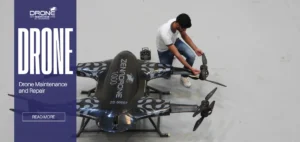
27 November 2025
The Ultimate Guide to Drone Maintenance and Repair
The Ultimate Guide to Drone Maintenance and Repair Flying a drone is exciting, but proper maintenance ensures smooth, safe, and...


















